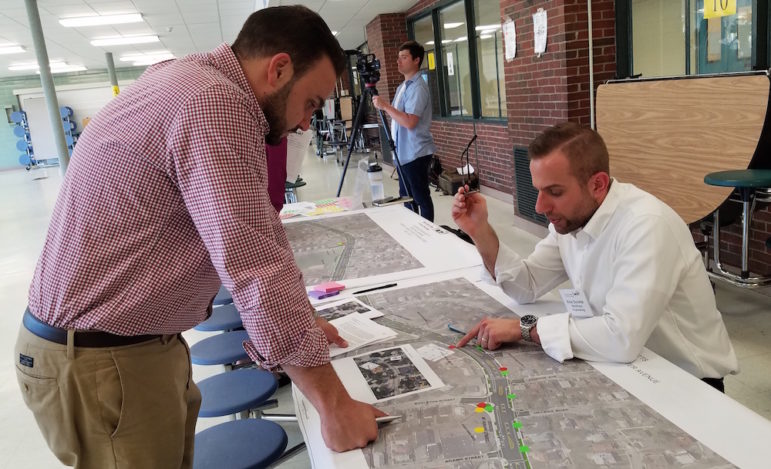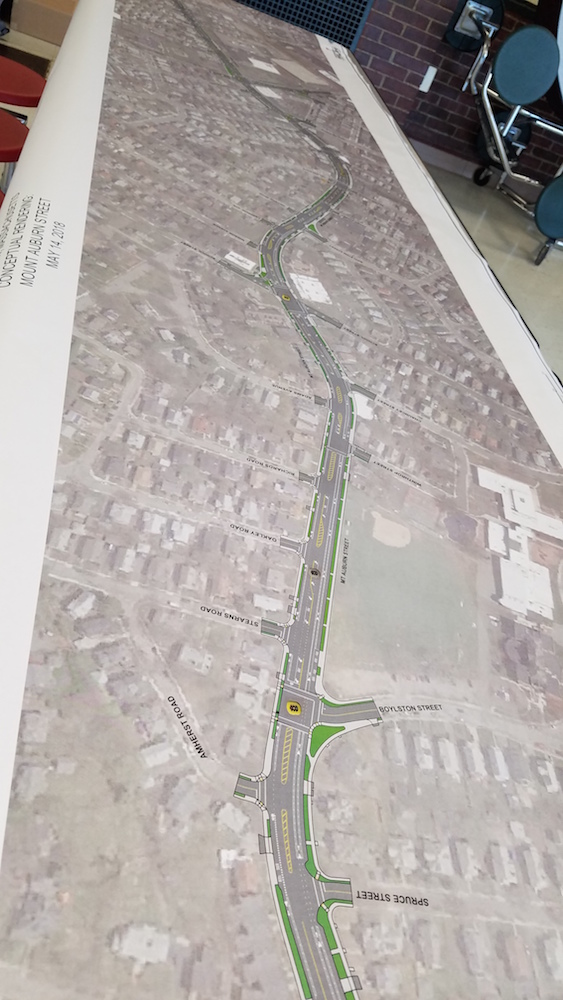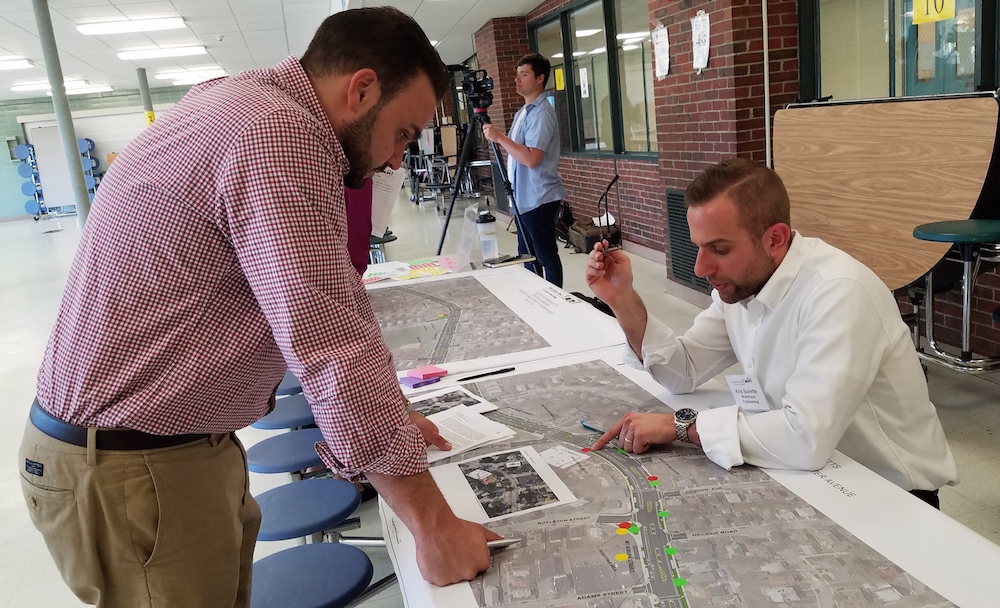
Charlie Breitrose
A resident speaks with a member of WorldTech, the town’s traffic engineering firm, about plans for redesigning Mt. Auburn Street.
Town officials laid out the latest plans for the renovation of Mt. Auburn Street Monday evening, which include one travel lanes for motor vehicles and separate bike lanes for most of the length of the town’s major artery.
Discussions of reducing the number of lanes on Mt. Auburn Street from two to one has been controversial since it was first discussed several years ago. The plans shown to the public at the Hosmer School Cafeteria had single lanes with turning lanes most of the way from Common Street east to the Cambridge line. Town officials said, however, that where it counts there are two lanes.
Even with a two-lane road, traffic backs up when cars wait to make a turn, said Department of Public Works Superintendent Gerry Mee.
“A two-lane road is effectively one lane with someone blocking lanes,” Mee said. “At the intersections we are not losing lanes.”
The number of lanes is not always the biggest factor in how many cars that a road can handle, said Assistant Town Manger and Director of Community Development and Planning Steve Magoon.
“It is important to remember that what controls the capacity of the street is the intersection, not the capacity of the lanes,” Magoon said.
As a metaphor, the number of people who can get into a room is not controlled by how big the hallway is, but how many people can fit through the doorway.
William Mertz, vice president of the town’s traffic engineering firm, WorldTech, said that intersections are where traffic slows, currently. When traffic backs up on a two-lane road without turn lanes, Mertz said, cars must either wait for the person turning left to clear or weave into the next lane, which can be dangerous because cars may be coming quickly from behind.
All the major intersections, and many smaller ones, have left turn lanes to move vehicles out of the way to allow traffic to flow, Mee said. The existing traffic lights, and planned new ones, will have left turn arrows.

Charlie Breitrose
A map stretching across two tables showing the entire length of Mt. Auburn Street. Plans call for making much of the roadway one lane each way with turning lanes rather than the current two lanes both ways.
Mt. Auburn Street is being designed as a Complete Streets project, which means it accommodates not just motor vehicles, but public transit, bicycles and pedestrians. The town will apply for Transportation Improvement Program (TIP) funding — federal dollars handed out by the state — to pay for the project, Magoon said.
“Part of applying for federal and state funds is to meet as many of their goals as possible,” Magoon said. “Complete Streets is important for that.”
Town officials have targeted 2022 as the year they would apply for funding, go out to bid and start construction.
The reduction of lanes has also been called a “road diet.” Other examples of narrowing of roads, and in most cases reducing lanes, in Watertown are: Main Street, Nonantum Road, Greenough Boulevard, North Beacon Street and Charles River Road. Another nearby example is the Belmont Street/Trapelo Road corridor.
Residents at Monday’s meeting got to speak with members of the Department of Public Works, the Department of Community Development and Planning and with traffic engineers from WorldTech. Attendees could also make suggestions for where to put street trees, bike racks and other amenities.
For bicycles, the plan has protected bicycle lanes along most of the roadway from Common Street east to the Cambridge line. There will be buffered bike lanes, with painted buffers between the bike lane and motor vehicles, on much of the length of the roadway. Closer to Watertown Square there will be traditional bike lanes, with a single stripe, and shared bike lanes (where bikes use the same lane as cars and other vehicles).
Public transportation is an important part of traffic on Mt. Auburn Street. The MBTA’s 71 bus carries 5,300 passengers on weekdays, with nearly 85 percent or riders taking it to work or school. Some bus stops would be moved in the plan. Many will move to the far side of intersections so that buses do not pull over, to let people on and off, and then get stuck at a light. Other improvements include bus pullouts (so the vehicles can get out of traffic), and improved amenities at bus stops, such as shelters and benches.
See more information and documents on the Mt. Auburn Street Project website, mountauburnstreet.com.

Lunacy!
Another stupid scheme by liberals because they have nothing better to do.
2 lanes to 1?
Why?!
Because you don’t need 2 lanes of travel. The recently redone Trapelo Road in Belmont shows how a major thoroughfare should be. Dedicated bike lanes, safe for pedestrians to cross at non-intersections, and turning lanes so you don’t get stuck behind people turning left or buses stopping for passengers.
Reminder of the policy, only one comment if you are not signing your full name.
Thanks,
Charlie
James
I do like some of Trapelo but there is also the other side which is lots of road rage and getting cut off when the road goes two to one two to one .Tradeoffs on both sides Thereare no good bike lines IMO unless they are somewhat protected even with a small burm between road and bike, cars drift into bike lane many times . I will continue to be safe and ride my bike on sidewalks since I’ve been swiped by cars on Trapelo in the past. Unfortunately with all the change on Mt Auburn , we will still have unprotected bike lanes, which is sad. Looks like the sidewalks will be a bike lane. Other than better predestrian crossing, protected bike lanes would have been a big win, without them IMO fix the lights and intersections for pedestrians and leave the rest of the road the same.
Driscollville is moving forward.
Just plain stupid. Just like they did on arsenal street. Wake up. The number of cars in and going through Watertown is only going up. These people are once again showing how incompetent they are not to mention what a waste of money this is.
Oh God, turning lanes. Have these clowns ever driving down main Street in Waltham and experienced what a complete failure it is? Obviously not.
Why do they need bicycle lanes. Do bicycle owners pay excise taxes to help with road repair and construction? I think that someone should propose a bill to the senate to add a “special” tax to bicycle owners to cover the cost of their own lanes on the new “liberal” roadways.
This has nothing to do with liberal or conservative. It is about fixing a road that hasn’t been updated in better than forty years. The bike lane is good and moving transit along better is a big pluss.
BTW, many bike owners pay excise tax because they also own cars. And they pay state and local taxes.
I don’t love everything about this, but we need to accommodate bikes and transit on Mt. Auburn. Remember John Q., every transit rider and every bike is one less car in your way. Also, if you are going to express strong opinions, why don’t you sign your real name?
So many bad ideas.
First off is where you put a bike lane.
It should be next to the sidewalk and shared with walkers. Not out with the cars. Much safer for bikers and cars.
2 Where is it that you are dealing with the delivery trucks that stop and block intersections? These trucks create very dangerous situations like where Starbucks blocks the bus stop on Mt Auburn and Patten and turning onto Patten St. then becomes extremely dangerous
Double parked Street deliveries should be banned if not already and enforced.
Then the biggest of all problems is fixing the log jam that happens during morning and evening rush hour. It happens on the Cambridge section between Aberdeen St. and Fresh Pond Parkway.
Reducing the lanes for trucks and cars to favor public trans is valuing certain people over others and not forward thinking.
More interactive resident involvement with group moderation should be done to better identify the problems and discover the best solutions.
I especially feel bad for the business along the street too. If you are going to eliminate parking then you should also plan for a parking garage in the area. where you are eliminating them.
And don’t give me this song and dance about how smart street lights will make these changes all better. They should be in place now making things all better!
Yikes.
🙂
Most of the parking in Coolidge Square will remain, but I think there is some being lost in the business area near Common Street.
With Watertown’s increasing population will come an increasing number of cars. You cannot stop that and the increased number of cars must be acommodated.
I’d like them to do a study of how many (percentage?) people would actually use the bike lane on a regular basis. I don’t see why a dedicated bike lane is needed if it’s rarely used. Personally, I would never bike to Harvard Sq. I’d take the bus.
And if you do have a bike lane, it should be completely separated and protected from vehicular traffic, not just painted.
Actually there are quite a few cyclists who use Mt. Auburn Street (I see them every day when I wait for the bus), even though it is currently very unsafe for them–I habitually avoid Mt. Auburn. The fact is that the younger people who are moving into Watertown tend to want to be less dependent on cars. Bike use will increase every year, especially if we provide good bike infrastructure. Good for you if you take the bus to Harvard Square.